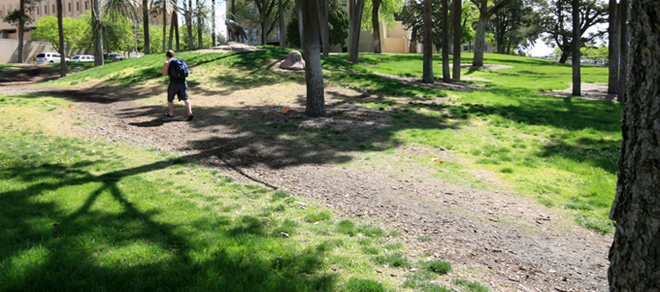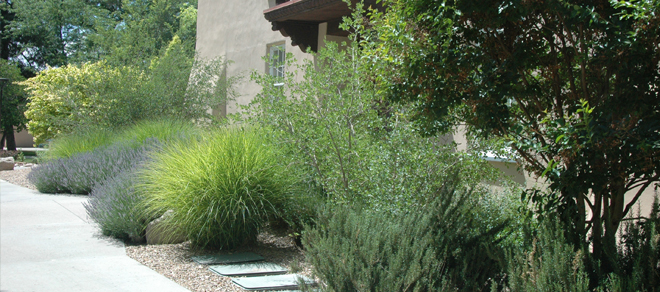Before anyone was saying “drought,” the University of New Mexico was implementing ways to conserve water. Gary Smith, associate director of environmental services and maintenance and operations in the Physical Plant Department, said that UNM has initiated measures that target indoor and outdoor water use.
“Our current goal is to achieve 3 – 5 percent water saving per year for the next five years. We have exceeded that goal in the past two years,” Smith said. “One of the biggest conservation initiatives has been in upgrading old galvanized, leaky irrigation systems that gave some areas too much, and other areas too little water.
Recent upgrades in Tight Grove, near Central and University, will save 500,000 gallons of water a year. “That took the efficiency from 25 percent to 65 percent. We can't go above that because of the mature trees,” he said.

Tight Grove – Conservation efforts have resulted in the savings of 500,000 gallons of water a year at Tight Grove located
in the southwest part of campus. Photo by John Sumrow
The trees are Ponderosa pines that are more than 100 years old. The area is also designated a historic campus landscape that must be maintained.
“We also recently over-seeded Tight Grove with turf grass. We got a variance from the Bernalillo County Water Authority to water during the day. We have to protect that investment,” Smith said.
A similar project took place between Zimmerman Library and Anthropology, which will save 2.3 million gallons per year in irrigation water. “We also have a monthly irrigation preventative maintenance program to quickly identify and repair broken irrigation equipment,” he said.
A pleasing campus environment is “intellectually stimulating.” “Sixty percent of freshmen say that the appearance of the campus is a factor in selecting a college,” Smith added.
Since 1995, PPD has removed approximately 40,000 square feet of high water use turf campus areas grass in favor of low-maintenance landscapes. The landscapes use native and low water xeric plants in concert with water conserving soil preparation and fertilization techniques. And, in 2010-2011, 80 percent of UNM irrigation was automated and set to evapotranspiration rates – the rate at which water is lost from the soil by evaporation and by transpiration of the plants.
“We've planted shade trees on the south and west sides of buildings to provide a cooler summer environment. In the winter, they lose their leaves and allow sun and heat into the buildings,” he said, adding that green space around buildings reduces energy use by 15 percent.

UNM has replaced high water use turf with low-maintenance landscapes with water conserving soil preparation and
fertilization techniques. Photo by Carolyn Gonzales
Other changes in turf management practices have resulted in additional water savings. Aerating the soil allows the water to soak in, adding compost material to hold water and raising the mowing heights to reduce evaporation are some of the ways PPD has added to water savings.
Indoor water saving comes from replacing all toilets and urinals with low flow. “Each toilet saves about 4,000 gallons per year, or a 20 percent saving,” he said, adding that all new construction must comply.
Equipment that used to be water cooled is now being changed out with air cooled systems. They are also recycling water from the evaporative cooler on the gas turbine for electricity generation, then diverting it to the plant's cooling towers that generate refrigeration.
They even changed out mops. “A microfiber mop uses one quart of water to clean twice the area of old mops, which used two and a half gallons of water per use,” he said.
Smith said, “All these conservation efforts have resulted in an overall 30 percent reduction in campus water use since 1994 despite seeing significant growth in the campus building footprints and landscape.”
While we continue to pray for rain, PPD is maximizing the use of the desert's most precious resource.
![UNM Takes Measures to Conserve Water [article image]](unm-water-conservation/water-conservation-banner.jpg)
